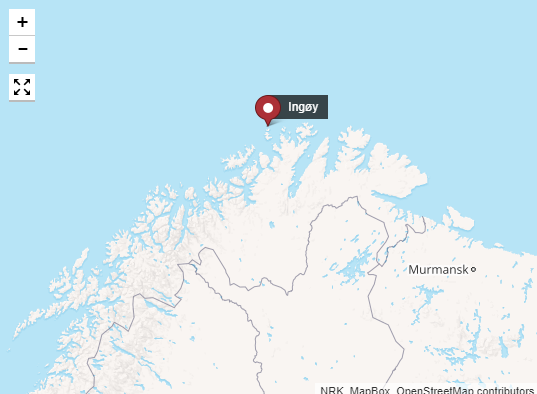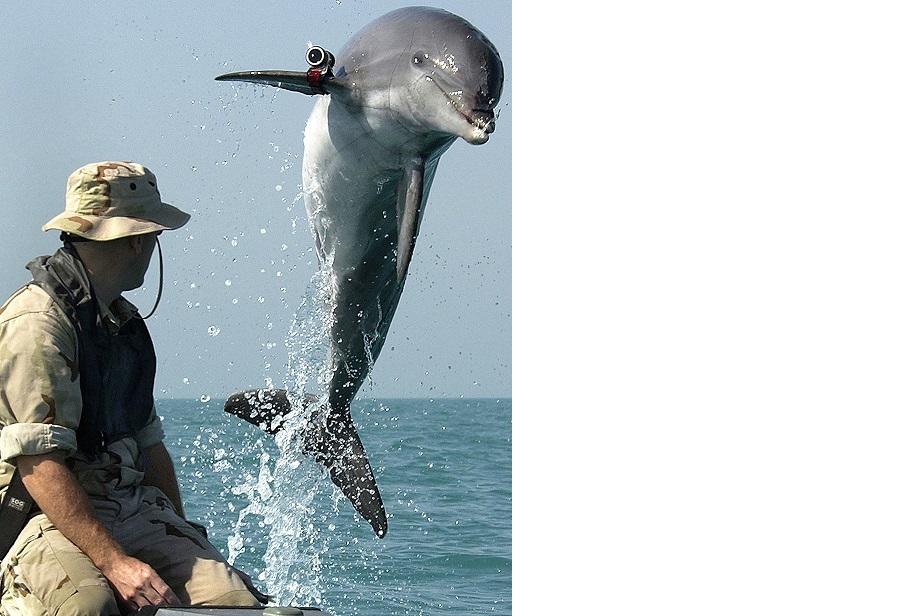Norwegian fisherman encountered what appears to be a Russian-trained beluga whale in the Barents Sea off the northeast coast of Norway on April 25.
Fitted with a camera harness that had Russian markings, the whale kept approaching the fishing boat and “rubbed up against it,” according to NRK and Ars Technica.
The harness was reportedly marked with the label “Equipment St. Petersburg” and had an attachment point for a GoPro camera. Audun Rikardsen, a professor at the Norwegian Arctic University in Tromsø (UiT), told Norway’s VG that neither Norwegian nor Russian academic researchers put harnesses on whales. “I have been in contact with some Russian researchers,” Rikardsen said. “They can confirm that it is nothing they are doing. They tell me that most likely is the Russian Navy in Murmansk.” –Ars Technica
“We were going to put out our nets when we saw a whale whale swimming between the boats,” said fisherman Joar Heston, who added “It came over to us, and as it approached, we saw that it had some sort of harness on it.”
After several failed attempts to remove the harness themselves, the fisherman sent photos to Norway’s Directorate of Fisheries, and reported that the whale was in distress. A fisheries boat in the area responded, and noted that “after a little lure with cod fillets, and with the fisherman Joar Hesten getting into the water wearing a survival suit, the inspectors Jørgen Ree Wiig and Yngve Larsen from the Marine Service and the Horse managed to release the whale,” according to a post on Facebook.
Military use of marine mammals goes back decades – with the United States’ program going back to at least the 1960s.
The Navy’s Marine Mammal Program began in 1960 with two goals. First, the Navy wanted to study the underwater sonar capabilities of dolphins and beluga whales to learn how to design more efficient methods of detecting objects underwater, and to improve the speed of their boats and submarines by researching how dolphins are able to swim so fast and dive so deep. In addition to this research component, the Navy also trained dolphins, beluga whales, sea lions and other marine mammals to perform various underwater tasks, including delivering equipment to divers underwater, locating and retrieving lost objects, guarding boats and submarines, and doing underwater surveillance using a camera held in their mouths. –PBS
A timeline of research via PBS:
1960’s navy begins use of marine mammals
1965 sea lab II
In 1965, the Marine Mammal Program began its first military project: Sea Lab II. Working in the waters off La Jolla, California, a bottlenosed dolphin named Tuffy completed the first successful open ocean military exercise. He repeatedly dove 200 feet to the Sea Lab II installation, carrying mail and tools to navy personnel. He was also trained to guide lost divers to safety.
1965-75 dolphins used in vietnam
The Navy sent five dolphins to Cam Ranh Bay to perform underwater surveillance and guard military boats from enemy swimmers. Although during this era rumors circulated about a “swimmer nullification program” through which dolphins were trained to attack and kill enemy swimmer, the Navy denies such a program ever existed.
1975 introduction of sea lions and beluga whales
With the success of the dolphin program, the Navy began working with sea lions, training them to recover military hardware or weaponry fired and dropped in the ocean. The sea lions could dive and recover objects at depths of up to 650 feet.
The Navy also began exploring the use of beluga whales, which, like dolphins, use sonar to navigate. Beluga whales could operate at much colder temperatures and deeper depths than either dolphins or sea lions.
1965-75 navy builds up collection of dolphins
The Marine Mammal Program reached its heyday in the 1980’s, with an expanded budget and increased number of dolphins. In 1986, Congress partially repealed the 1972 Marine Mammal Protection Act by letting the Navy collect wild dolphins from for “national defense purposes.” The Navy planned to use the dolphins to expand its mine disposal units and to stock a breeding program.
1986-88 dolphins in the persian gulf
The navy sent six dolphins to the Persian Gulf, where they patrolled the harbor in Bahrain to protect US flagships from enemy swimmers and mines, and escorted Kuwaiti oil tankers through potentially dangerous waters. One of the dolphins, “Skippy,” died of a bacterial infection.
1986-88 missile guarding project in bangor abandoned
In the late 1980’s the Navy began a project through which dolphins would act as guards at the Bangor Washington Trident Missile Base. Animal activists opposed the project, and filed suit against the Navy under the National Environmental Protection Act claiming that the Navy must do an environmental evaluation to determine whether deployment in the cold northern waters off Bangor would harm dolphins originally captured in the Gulf of Mexico. A judge ruled that such a study must be completed before the project could continue. The Navy abandoned the project.
By 1994, the Navy policy on moving dolphins to environments with radically different water temperatures changed; a spokesperson said that in general, the Navy would only move dolphins between environments with a 20 degree difference in temperature, except in emergency situations.
1990s downsizing, declassification, retirement
With the end of the Cold War, the Navy’s budget for the marine mammal program was drastically reduced, and all but one of its training centers were closed down. Of the 103 dolphins remaining in the program, the Navy decided it needed only 70 to maintain its downsized operations. Much of the project was declassified, although certain details remain protected.
This raised the question of what to do with the remaining dolphins. In the 1992 Defense Appropriations Act, Congress alloted a half million dollars to the Navy to “to develop training procedures which will allow mammals which are no longer required for this project to be released into their natural habitat.” The Navy held two conferences of researchers and experts and determined that a reintroduction program would not be cost effective.
In an attempt to downsize its dolphin troops, the Navy offered to give its surplus trained dolphins to marine parks. However, interest in the free dolphins was low because many marine parks by this time had developed successful in-house breeding programs. The Navy only got only four requests, but pledged to care for the unclaimed dolphins until their deaths.
Later in 1994, the Navy agreed to send three dolphins to Sugarloaf sanctuary, near Key West in Florida, a rehabilitation facility run by Ric O’Barry. O’Barry planned to reeducate the dolphins so they could be safely released into the wild, once the necessary federal permits were granted.
1996 illegal release of Luther and Buck
Two of the dolphins being held at the Sugarloaf Sanctuary, Luther and Buck, were being prepared for life in the wild while awaiting federal permits for their release. In May, before the permits had been issued, O’Barry released the dolphins into the Gulf of Mexico. He believed that the dolphins were ready for release and that the bureaucratric requirements for a permit were designed to prevent the release of the Navy dolphins. He thought that to wait any longer before letting them go would jeopardize their chances of successful adaptation to the wild.
read O’Barry’s defense of his actions, and criticism of the release from Naomi Rose
The dolphins were recaptured less than two weeks later and returned to the Navy. All three of these dolphins are now back with the Navy. One of them is still in Florida;the other two are back in San Diego in the Navy facility there.
1997 Ukrainian dolphins trained by the Soviet Navy for military operations are now being used for therapy with autistic and emotionally disturbed children.
***
And it looks like it didn’t end there. In 2000, it was reported that the Soviet Navy sold their killer dolphins to Iran – while in 2005, there were reports that some of the US military’s trained dolphins based on Lake Pontchartrain escaped during the Hurricane Katrina flooding. In 2007, the US Navy spent $14 million on marine animal weapons research.
In 2014, it was reported that Russia stole Ukraine’s “killer dolphin army” during the annexation of Crimean naval bases.
As you may have heard in the past, the Ukrainian navy has a group of around ten dolphins in Sevastopol that are on active military duty. The dolphins partake in “training exercises for counter-combat swimmer tasks in order to defend ships in port and on raids.” And how exactly do they defend ships? With the knives and pistols attached to their adorable dolphin heads, of course. –The Atlantic
In March of 2013, three of Russia’s killer dolphins allegedly escaped the military base in Sevastopol. According to former Soviet Naval anti-sabotage officer Yury Plyachenko, “there were repeatedly cases in the 1980s when control was lost over dolphins. If a male dolphin saw a female dolphin during the mating season, he would immediately set off after her and would no longer obey any commands. But in a week or so he’d come back.”
We wonder if the Beluga whale (which doesn’t eat Krill, by the way), was similarly looking for love?
Only one question remains; who was flipper working for?
via ZeroHedge News http://bit.ly/2PCbV6L Tyler Durden


